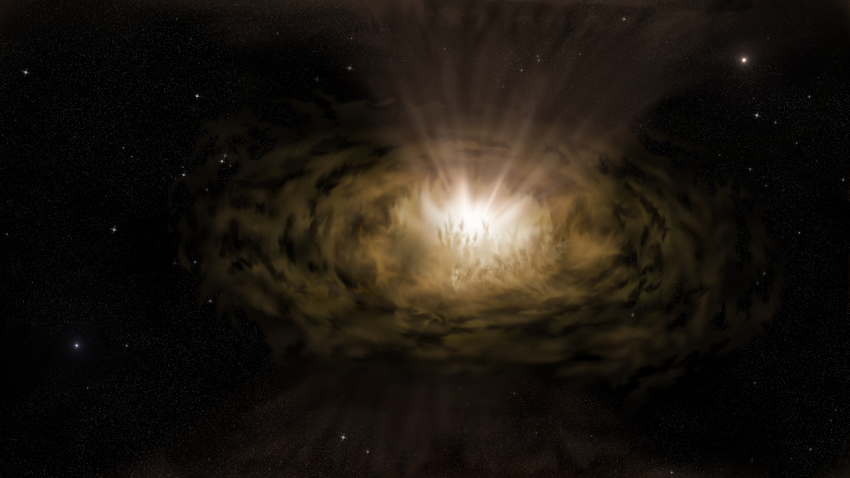A new study indicates that scientists have substantially underestimated the energy output of active galactic nuclei by not recognising the extent to which their light is dimmed by dust. The work is published in Monthly Notices of the Royal Astronomical Society.
Powered by supermassive black holes swallowing matter in the centres of galaxies, active galactic nuclei are the most powerful compact steady sources of energy in the universe. The brightest active galactic nuclei have long been known to far outshine the combined light of the billions of stars in their host galaxies. Although the possibility of dust dimming the light from active galactic nuclei has been recognised for a long time, the amount has been considered controversial and was widely believed to be negligible.
Now, the new research reveals that the energy output of active galactic nuclei is underestimated. The team reached this conclusion by studying the reddening effect of dust on the light fromone of the most well-studied active galactic nuclei, known as NGC 5548. Just as the Earth’s atmosphere makes the Sun appear redder as well as dimmer at sunset, so dust in active galactic nuclei also makes them appear redder than they really are. The amount of reddening correlates with the amount of dimming.
Scientists quantify the colours of an object by measuring the ratios of the intensity of its light at different wavelengths. While we know what the unreddened colour of the Sun is, there has been much debate over the unreddened colours of the various types of emission from active galactic nuclei. This is because, although simple theories predict the intrinsic, unreddened colours, there were doubts about whether these simple theories applied to active galactic nuclei.
In the new study of NGC 5548, the UCSC researchers used seven different indicators of the amount of dust and found them all to be in good agreement. Furthermore, the dimming of NGC 5548 due to dust was found to be large, more than ten times the dimming caused by dust as we look out of our own galaxy, the Milky Way.
The colours of NGC 5548 are typical of other active galactic nuclei, which has wide- ranging implications. Because of the dimming effects of dust, active galactic nuclei are even more powerful than had been realised. The results imply that in the ultraviolet, where most of the energy is radiated, a typical active galactic nucleus is putting out an order of magnitude more energy than previously thought.
Another implication is that active galactic nuclei are very similar, and what had hitherto been thought to be major fundamental differences between them are really just the consequences of different amounts of reddening by dust.
“When there are intervening small particles along our line of sight, this makes things behind them look dimmer. We see this at sunset on any clear day when the sun looks fainter,” said Dr Martin Gaskell, a research associate in astronomy and astrophysics at UC Santa Cruz and lead author of the paper. “The good agreement between the different indicators of the amount of reddening was a pleasant surprise,” said Gaskell. “It strongly supports simple theories of emission from active galactic nuclei. Exotic explanations of colours are not needed. This makes life simpler for researchers and is speeding up our understanding of what happens as black holes swallow material,” Gaskell said.
Media contacts
Gurjeet Kahlon
Royal Astronomical Society
Mob: +44 (0)7802 877700
press@ras.ac.uk
Dr Robert Massey
Royal Astronomical Society
Mob: +44 (0)7802 877699
press@ras.ac.uk
Science contacts
Dr Martin Gaskell
University of California Santa Cruz
mgaskell@ucsc.edu
Further information
Gaskell’s co-authors—Frances Anderson (now at Harvey Mudd College), Sufia Birmingham (now at Princeton University), and Samhita Ghosh (now at UC Berkeley)—worked on thisproject as high school seniors participating in the UCSC Science Internship Program.
The work appears in ‘Estimating reddening of the continuum and broad-line region of active galactic nuclei: the mean reddening of NGC 5548 and the size of the accretion disc ’, Gaskell et al., published in Monthly Notices of the Royal Astronomical Society, in press.
Notes for editors
The Royal Astronomical Society (RAS), founded in 1820, encourages and promotes the study of astronomy, solar-system science, geophysics and closely related branches of science. The RAS organises scientific meetings, publishes international research and review journals, recognises outstanding achievements by the award of medals and prizes, maintains an extensive library, supports education through grants and outreach activities and represents UK astronomy nationally and internationally. Its more than 4,000 members (Fellows), a third based overseas, include scientific researchers in universities, observatories and laboratories as well as historians of astronomy and others.
The RAS accepts papers for its journals based on the principle of peer review, in which fellow experts on the editorial boards accept the paper as worth considering. The Society issues press releases based on a similar principle, but the organisations and scientists concerned have overall responsibility for their content.
Keep up with the RAS on Twitter, Facebook, Instagram, LinkedIn, and YouTube.


